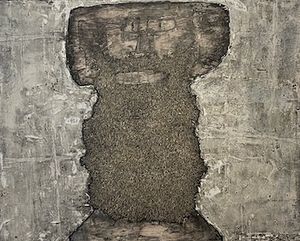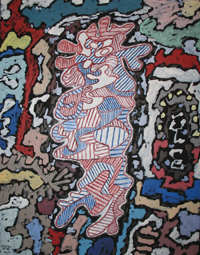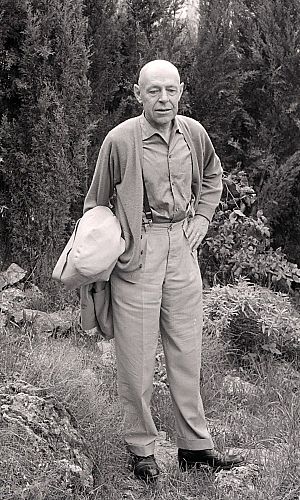Jean Dubuffet facts for kids
Quick facts for kids
Jean Dubuffet
|
|
|---|---|

Jean Dubuffet in 1960
|
|
| Born | 31 July 1901 Le Havre, France
|
| Died | 12 May 1985 (aged 83) Paris, France
|
| Known for | Painting, sculpture |
Jean Philippe Arthur Dubuffet (born July 31, 1901 – died May 12, 1985) was a famous French painter and sculptor. He had a unique idea about art. He liked what some people called "low art" and didn't care for traditional ideas of beauty. Instead, he wanted art to be more real and human.
Dubuffet is most famous for starting an art movement called art brut. This means "raw art." He also created a special collection of these artworks, called Collection de l'art brut. Dubuffet had a very busy art career in both France and America. His work was shown in many exhibitions during his life.
Contents
Discovering Jean Dubuffet's Early Life
Dubuffet was born in Le Havre, France. His family were wealthy wine merchants. As a child, he became friends with writers like Raymond Queneau. In 1918, he moved to Paris to study painting. He went to the Académie Julian. There, he became good friends with artists like Juan Gris.
After six months, he left the school. He didn't like the traditional way of learning art. Dubuffet then explored other interests. These included music, poetry, and learning old and new languages. He also traveled to Italy and Brazil. In 1925, he returned to Le Havre and got married. He later started a small wine business in Paris.
He began painting again in 1934. He made many portraits, focusing on art history styles. But he stopped painting again to work on his wine business.
Exploring Dubuffet's Early Artworks
In 1942, Dubuffet decided to focus on art once more. He often chose everyday subjects for his paintings. These included people on the Paris Métro or walking in the countryside. Dubuffet used strong, bright colors in his art. This was similar to the style of Fauvism.
Many of his paintings showed people in small, crowded spaces. This made viewers feel a certain way. In 1943, his friend Georges Limbour introduced him to writer Jean Paulhan. Paulhan was very impressed by Dubuffet's unknown work. This meeting was a big moment for Dubuffet. His first solo art show opened in October 1944. It was at the Galerie Rene Drouin in Paris. This was his third try at becoming a known artist.
In 1945, Dubuffet saw a show by Jean Fautrier. He was very impressed. He felt Fautrier's art showed deep human feelings. Dubuffet started to use thick oil paint. He mixed it with materials like mud, sand, and glass. This allowed him to paint without a brush. He could create textures and marks directly in the paint.
This technique was best seen in his 'Hautes Pâtes' series. This means 'Thick Impastoes'. He showed these works in 1946. Critics had mixed feelings about his art. Some called it "anarchy." But others, like Clement Greenberg, praised his originality. Dubuffet became very active in the United States after his first New York show in 1951.
After 1946, Dubuffet started painting portraits of his friends. He used the same thick materials. He wanted these portraits to be less about psychology. A few years later, he joined the surrealist group. He was also friends with the playwright Antonin Artaud. He had a strong connection with Jean Paulhan. Paulhan was a French writer who fought against "intellectual terrorism."
Understanding the Art Brut Movement

Between 1947 and 1949, Dubuffet visited Algeria three times. Algeria was a French colony then. He went there to find new art ideas. He was interested in the nomadic tribes. He admired how they moved around and didn't stay in one place. This idea of constant change became part of his art brut concept.
In June 1948, Dubuffet and others started La Compagnie de l'art brut in Paris. This group looked for, documented, and showed art brut. Dubuffet collected many such artworks himself. These included pieces by Aloïse Corbaz. His collection is now at the Collection de l'art brut in Lausanne, Switzerland. This collection is like a "museum without walls." It crosses borders and cultures.

Dubuffet created the term art brut. It means "raw art" or "outsider art." This art is made by people who are not professional artists. They work outside normal art rules. This includes art by psychiatric patients, prisoners, and children. Dubuffet believed that everyday life had more art and poetry than traditional art.
He felt academic art was boring and snobby. He wrote that he wanted his art to please "the man in the street." He wanted to make friends with everyday people. He aimed to create art that everyone could enjoy. As a result, his work often looks simple and childlike. It is sometimes compared to wall drawings or children's art.
However, Dubuffet was very smart when writing about his art. Some critics noted that his writings were very clever. This made his claim of being a "naive" artist seem less true.
Exploring Dubuffet's Artistic Style
Dubuffet's art often used unusual materials. Many of his paintings were made with oil paint. He made the paint very thick by adding things like sand, tar, and straw. This gave his art a unique texture. Dubuffet was one of the first artists to use this thick paint, called bitumen.
In his early paintings, he didn't use normal perspective. Instead, he showed space in a flat, two-dimensional way. He created the idea of depth by overlapping objects. This method made his works feel crowded.
From 1962, he started using only red, white, black, and blue colors. By the late 1960s, he focused more on sculpture. He made sculptures from polystyrene. Then he painted them with vinyl paint.
Other Creative Projects
In 1960–1961, Dubuffet began trying out music and sounds. He made recordings with Danish painter Asger Jorn. Around the same time, he started making sculptures. He used everyday materials like papier-mâché. He especially liked light materials like polystyrene. These allowed him to work quickly.
In the late 1960s, he started creating large sculptures that people could walk inside. Examples include 'Tour aux figures' and 'Jardin d'Hiver'. In 1974, Dubuffet created Jardin d'émail. This was a very large outdoor painted sculpture. It was made for the Kröller-Müller Museum.
In 1978, Dubuffet worked with American musician Jasun Martz. He created the album artwork for Martz's symphony, The Pillory. This drawing has been used on many record albums and CDs worldwide.
Jean Dubuffet's Passing
Dubuffet died in Paris on May 12, 1985. He passed away from a lung disease called emphysema.
Exhibitions of Dubuffet's Work
The Fondation Jean Dubuffet collects and shows his art today.
Here is a list of some of his exhibitions:
- 1944: Galerie Rene Drouin, Paris
- 1946: Galerie Rene Drouin, Paris
- 1951: Pierre Matisse Gallery, New York (29 works)
- 1955: Institute of Contemporary Arts, London (56 works)
- 1957: Stadtisches Museum, Leverkusen (87 works)
- 1958: Arthur Tooth and Sons, London (31 works)
- 1959: Pierre Matisse Gallery, New York (77 works)
- 1960: Arthur Tooth and Sons, London (40 works)
- 1960: Kestner-Gesellschaft, Hanover (88 works)
- 1960: Musee des Arts Decoratifs, Paris (402 works)
- 1960: Hanover Gallery, London (27 works)
- 1962: Museum of Modern Art, New York (85 works)
- 1962: Robert Fraser Gallery, London (60 works)
- 1963: Galleria Marlborough, Rome (68 works)
- 1964: Robert Fraser Gallery, London (18 works)
- 1964: Palazzo Grassi, Venice (107 works)
- 1964-5: Stedelijk Museum, Amsterdam (198 works)
- 1964-5: Galerie Jeanne Bucher, Paris (18 works)
- 1964-5: Galerie Claude Bernard, Paris (46 works)
- 1965: Galerie Beyeler, Basel (88 works)
- 1965: Gimpel Hanover Galerie, Zurich (34 works)
- 1966: Institute of Contemporary Arts, London (76 works)
- 1966: Robert Fraser Gallery, London (13 works)
- 2019: Jean Dubuffet: un barbare en Europe MuCEM, Marseille, France
- 2021: Jean Dubuffet: Brutal Beauty, Barbican Art Gallery, London
Notable Artworks by Dubuffet
- La Chiffonnière
- Monument with Standing Beast (1984)
- Monument au Fantôme
Auction Records for Dubuffet's Art
In June 2019, one of his works sold for a record price. His painting Cérémonie (Ceremony) sold for $11.1 million at Christie's auction house.
In April 2021, Jean Dubuffet’s La féconde journée (1976) was sold for £3.6 million. This happened at a modern art auction in London.
See also
 In Spanish: Jean Dubuffet para niños
In Spanish: Jean Dubuffet para niños


